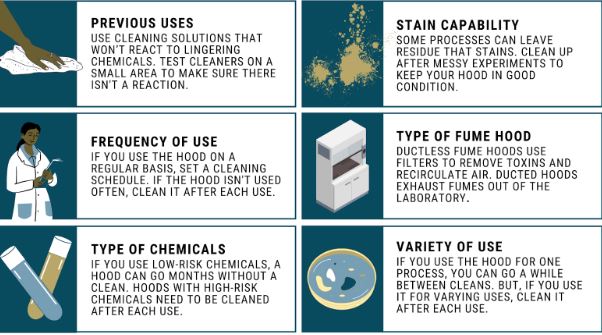Working in a laboratory usually involves hazardous chemicals and materials and a poorly maintained fume hood can compromise both your research results and your team’s safety.
Like any equipment, fume hoods need regular cleaning to keep them in good condition. It’s important to maintain your fume hood because it exhausts harmful toxins out of the lab. A malfunctioning hood could create a serious hazard.
The best cleaning products for each surface
First, make sure that the cleaning agents will not react with the chemicals in the hood.
- Polyglass Liner: Mild soap and water.
- Sash Glass: Commercial glass cleaner.
- Painted Steel Surfaces: Mild soap and water, ethyl alcohol or commercial glass cleaner.
- Epoxy Liner and Worktops: Mild soap and water, solvent, or commercial glass cleaner.
- Plumbing Fixtures: Fixtures have a corrosive resistant coating. Mild soap or detergent only. Do not use an abrasive cleanser.
Most hood surfaces are stainless steel. Use wire wool to scrub these clean with mild soap and water, ethyl alcohol, or glass cleaner. If you use acids (or emit acidic vapors) in a fume hood, then even stainless steel will rust or corrode. A layer of wax can help to prevent this, but is also stripped by solvents and can make a steel surface slippery.
For wood or plastic bench tops, a thin veneer of silicone oil or wax keeps them shiny and easier to clean. Organic solvent spills can strip the oil or wax off, so it’s a good idea to apply it after a significant spill.
How often to clean a fume hood
Cleaning frequency depends on the type of fume hood, chemicals, and processes.
- Type of fume hood: Ductless fume hoods need filters to remove toxins to recirculate air into the lab. Make sure you’re using the right filter for the chemicals you intend to use in the hood. Ducted hoods will exhaust fumes out of the laboratory.
- Previous uses: What sort of chemicals were last used in the fume hood? Make sure to use cleaning solutions that won’t react to lingering chemicals. Mild soap and water is the safest option. Test your cleaning products on a small area first to make sure there aren’t any damaging reactions.
- Variety of use: If you use the hood for the same process regularly, you may be able to go a long time between cleaning. But, if you’re using the hood for a variety of processes, you need to clean it before you change processes.
- Frequency of use: If you use a fume hood on a regular basis, develop a cleaning schedule. If your hood isn’t used often, clean it immediately afterward. Ducted fume hoods used with low-risk chemicals can go months without a clean. Fume hoods used for dangerous or varied processes need cleaning after every use.
A busy lab that skips a weekly cleaning can cause residue buildup that damages the hood’s interior. - Type of chemicals: Certain chemical residues may be dangerous if left inside. Perchloric acid hoods come with a washdown system to prevent residue from exploding.
- Stain capability: Although stains won’t hurt, it’s nice to have your equipment look good. Certain processes can leave a residue that stains, such as soot. Clean up after messy experiments to keep your fume hood in good condition.
If you have a ductless hood, check the filters to make sure they’re clean and replace clogged filters. Filters are necessary because they remove hazardous fumes and particles.
Cleaning maintenance
Clean sashes, hood surfaces, and the light panel on a regular basis. If a spill or splash occurs, wipe the glass clean right away. Clean spills with deionized water, then wipe down with mild soap and water.
Also, lab personnel should always wear the appropriate PPE when cleaning a fume hood. This will protect them from the chemicals.
To learn more about fume hood maintenance and care, check out these articles:




